
‘BEARER
OF GOOD NEWS’
RICK KARLE is Spreading His Positivity Through New Media
COFFEE ALTERNATIVE
Alabama-Made FigBrew
Growing in Popularity
THANKSGIVING SIDE DISHES



‘BEARER
RICK KARLE is Spreading His Positivity Through New Media
COFFEE ALTERNATIVE
Alabama-Made FigBrew
Growing in Popularity
THANKSGIVING SIDE DISHES




Now entering its thirteenth year, Villa Rica's Winter Wonderland train ride features a mile-long train track decorated with over ten miles of light, free pictures with Santa, and a nightly fire pit where visitors can buy and roast gourmet s’mores. In addition to the yearly offerings of free parking, and space to write letters to Santa, be on the lookout for photographic opportunities with fun characters like our Yeti, elves, and teddy bear. No matter the age, Winter Wonderland is sure to wow the entire family!
TICKETS ON SALE NOVEMBER 1
Manager Mark Stockton
ALABAMA LIVING is delivered to some 450,000 Alabama families and businesses, which are members of 22 not-for-profit, consumer-owned, locally directed and taxpaying electric cooperatives. Subscriptions are $15 a year for individuals not subscribing through participating Alabama electric cooperatives. Alabama Living (USPS 029-920) is published monthly by the Alabama Rural Electric Association of Cooperatives. Periodicals postage paid at Montgomery, Alabama, and at additional mailing office.
ALABAMA RURAL ELECTRIC ASSOCIATION
AREA President, CEO
Karl Rayborn
Editor Lenore Vickrey
Managing Editor
Allison Law
Senior Graphic Designer
Sean Burnley
Art Director
Danny Weston
Advertising Director
Jacob Johnson
Graphic Designer/Production Coordinator
Brooke Echols
ADVERTISING & EDITORIAL OFFICES:
340 TechnaCenter Drive
Montgomery, Alabama 36117-6031
1-800-410-2737
For advertising, email: advertising@areapower.com
For editorial inquiries, email: contact@alabamaliving.coop
NATIONAL ADVERTISING REPRESENTATIVE:
American MainStreet Publications
611 South Congress Ave., Suite 504 Austin, Texas 78704
1-800-626-1181
www.AMP.coop
www.alabamaliving.coop


Sometimes the best part about Thanksgiving dinner isn’t the turkey, it’s the
USPS 029-920 • ISSN 1047-0311


9
Our readers have many reasons to be thankful this season, and family tops the list.
A Huntsville couple is gaining fans and awards nationwide for their unique coffee alternative made from roasted figs.
Each autumn brings a new reason to fall for The Bakehouse, a combo coffee shop, bakery and cafe in Fort Payne.




Board of Trustees
John Shewbart
President
Steve McGuire Vice President
Bobby Hooper
Secretary-Treasurer
Roger Boyd
Donna Hester
Stanley Holland
James McKinney
Jimmy Montgomery
Debbie King Taylor
It’s hard to imagine what our daily lives would be like without electricity. Every year, our dependence on what travels across poles and wires to our homes and businesses grows. We act as though electricity has always been there, take its presence for granted, and can’t imagine life without it. Even the shortest power outage manages to turn our world upside-down.
But 90 years ago, when President Franklin Roosevelt signed the executive order that created the Rural Electrification Administration (REA), nobody in America’s small towns and wide-open spaces took electricity for granted. That’s because most of them didn’t have access to it.
As the 19th Century drew to a close, wealthy investors were starting electricity utility companies in cities from coast to coast. Building power plants and installing power lines was costly, so investors focused their effort in places with the highest population density. Few gave any thought to rural America. Built-up areas offered more customers in smaller spaces, which helped those utilities become highly profitable. Running power lines to serve a handful of consumers spread across so many thousands of acres just didn’t make economic sense, so most utilities ignored them. After all, they couldn’t make as much money serving those places.
pay electric bills, then use most of that money to purchase and deliver electricity. They typically set aside some money for the future and emergency needs. And, because they employ local people who patronize local businesses, much of the money they earn stays in the communities they serve, boosting the local economy.
Most co-ops purchase electricity on the wholesale power market and turn around and sell it to members at a slight markup designed to cover the costs associated with operating the co-op and maintaining the infrastructure for delivering power. That’s why co-ops don’t make more money when you use more power, or when wholesale prices increase. It’s also why they are dedicated to helping their members reduce energy consumption and lower their power bills.
Because co-ops exist to serve their members and not profit-hungry investors, they have an obligation to keep the price of electricity as low as possible. When members spend less for their electricity, they have more money to use on what’s important to them.
Headquarters:
P.O. Box 10
Russellville, AL 35653
256-332-2730
District Office: P.O. Box 386 Red Bay, AL 35582
256-356-4413
Long after their city cousins became accustomed to enjoying the wonders of electric lighting and the earliest home appliances, folks in more remote areas could only dream about the convenience. The REA was created to change that, providing a source of expertise and financing for a new concept in energy: the rural electric power cooperative.
Besides the areas each served, the most important distinctions between those big utilities and the new co-ops involved who owned them and their purpose. As the name implies, investor-owned utilities are owned by people who buy stock in the utilities. The primary goal of those utilities is to make money to distribute to their investors through dividends and generate higher per-share prices to increase those investors’ wealth.
Electric cooperatives are built and owned not by investors, but by the very people they serve. They’re led by boards of local residents who are elected by their neighbors to represent them and are responsible for acting in the members’ best interests.
The primary goal of a co-op isn’t to make money, but to provide a safe and reliable source of electricity at a cost the local community can afford. As not-for-profit organizations, they receive their money from members when they
When the leaders of investor-owned utilities make decisions, their first thought is how those choices will affect the price of their company’s stock. When co-op leaders make decisions, they’re focused on doing the best thing for their members. Instead of trying to impress Wall Street, co-ops want to make sure they’re meeting your needs for power at the best price possible. That’s because they’re truly not for profit—instead, they’re for you and your neighbors.

By Abby Berry

Lighting is something most of us don’t think much about — until it’s wrong. Maybe the living room feels too dim for reading, or the kitchen lights cast an odd yellow glow. We often grab whatever bulb or fixture looks good without considering how it will actually perform in the space. But with a little planning, you can make your home brighter, cozier and more energy efficient.
When you’re shopping for light bulbs, it’s easy to focus on watts, but watts only measure how much energy a bulb uses. When it comes to brightness, what really matters is the lumen count. Lumens measure the actual light output. For example, an 800-lumen bulb gives off about the same amount of light as an old-fashioned 60-watt incandescent bulb. (You’ve likely replaced all incandescent bulbs with long-lasting, energy efficient LEDs, but if not — it’s time to make the switch!)
A helpful rule of thumb: higher lumens mean brighter light, while lower watts mean less energy consumed. Remember to check wattage ratings for fixtures and only install bulbs that meet the fixture’s wattage safety requirements.
Light bulbs also vary in color temperature, which ranges from warm yellow to cool white or even bluish tones. This detail often gets overlooked — until you replace one bulb and notice the new light doesn’t quite match the others. If mismatched tones drive you crazy, consider buying and installing bulbs of the same brand and wattage in a room at the same time. That way, the look stays consistent, and you won’t be stuck hunting for a perfect match later.
Installing dimmers instead of standard on/off switches can be a game changer. Dimmers give you more control over brightness, help save energy and create a more comfortable atmosphere. Not all bulbs are dimmable, so double check labels before buying.
While you’re thinking about switches, consider whether you have enough of them — and in the right places. A light you can only turn off from one end of a hallway quickly becomes annoying. For new installations or upgrades, it’s best to hire a licensed electrician to ensure everything is wired safely and efficiently.
Bulbs are only part of the equation — fixtures matter too. Each type serves a purpose. Ambient lighting, like sconces or glass-covered ceiling fixtures, provides general illumination. Task lighting, like pendants, desk lamps or track lighting, focuses light where you need it most.
When choosing a fixture, think beyond looks. Ask yourself: does this light provide the right amount of brightness for the space? A beautiful chandelier might look perfect over the dining table but leave the rest of the room too dim. Alternatively, an oversized fixture could flood the room with more light than you need, wasting both energy and money.
Smart lighting adds another layer of control for illuminating your home. But the real magic is convenience. With smart bulbs, you can adjust brightness, set schedules or even change colors — all from your phone or a voice assistant like Alexa or Google Assistant. Want the lights to dim automatically for movie night? Or to turn on before you get home? Smart bulbs make it easy.
Smart lighting also lets you personalize your space. You can go classic with warm white tones or experiment with colors to set the mood — anything from a soft glow for winding down to vibrant hues for a party. Remember, smart bulbs still rely on power from your wall switch, which needs to stay in the “on” position for remote controls to work. If you prefer using a physical switch, consider pairing smart bulbs with a smart light switch. Many of today’s smart switches also come with motion detectors, adding another level of efficiency and convenience.
Good lighting doesn’t just make your home look better — it makes it feel better too. With a little planning, you can create spaces that are welcoming, functional and energy efficient. Whether you stick to traditional bulbs and fixtures or explore the flexibility of smart lighting, thoughtful choices today will brighten your home for years to come.
Abby Berry writes on consumer and cooperative affairs for the National Rural Electric Cooperative Association, the national trade association representing nearly 900 local electric cooperatives. From growing suburbs to remote farming communities, electric co-ops serve as engines of economic development for 42 million Americans across 56% of the nation’s landscape.
AI can analyze historical data on the demand for electricity, weather trends and consumer behavior to forecast future demand requirements.

By Shane Schwartz
Artificial intelligence (AI) is no longer a trendy, high-tech buzzword for the exclusive domain of data scientists and Silicon Valley firms. Today, electric cooperatives across the country are discovering how AI — particularly generative AI and large language models (LLMs) like ChatGPT and Gemini — can transform the way they power their local communities. From improving reliability and safety to enhancing member services and streamlining daily operations, AI is helping electric co-ops do more with less.
Cooperatives are known for wearing many hats — from utility operators to first responders, to local economic development engines. But for many co-ops, limited staffing and tight budgets can make it difficult to explore new technologies.
AI tools, especially LLMs, now offer copy-and-paste workflows that anyone can use. Whether you’re a system engineer, a vegetation manager or a communications specialist, AI can act as a digital assistant — automating routine tasks, analyzing data and accelerating insights without any coding skills required. Even for experienced programmers, AI offers value. Those with technical backgrounds can use AI to rapidly test models, tune code or generate outputs in a timelier manner. But the real innovation is that now, anyone at an electric co-op can access the benefits of advanced analytics and automation.
While the specific tools and datasets may vary, most AI applications follow a simple process:
1. Gathering Data: Relevant information can be pulled from internal systems or spreadsheets.
2. Understand Data: AI can be used to summarize, structure or flag any potential issues in the dataset.
3. Apply a Prompt: Use a tested prompt to ask AI to perform a specific task or analysis.
4. Put AI to Work: AI-generated insights or outputs can be utilized to inform business decisions or create deliverables.
These tasks often take just a few hours to complete. Yet the time saved — and the ability to tackle previously outof-reach projects — can have long-lasting, positive impact across multiple departments. Let’s take a look at some of the most promising applications for AI.
AI can analyze historical data on the demand for electricity, weather trends and consumer behavior to forecast future demand requirements. With simple prompt-based tools, electric co-ops can generate accurate predictions — helping them plan for high-demand periods without complex software or deep technical expertise.
AI can quickly scan SCADA systems, automated meter data or voltage datasets to detect unusual patterns — identifying issues like mis-phased meters or early signs of equipment failure before they escalate into power outages.
By combining satellite imagery, LiDAR data and AI-powered image recognition, co-ops can assess and prioritize vegetation encroachments more efficiently — proactively preventing disruptions and reducing manual fieldwork.
AI can draft job hazard analyses, summarize safety reports or even generate site-specific assessments — all in minutes. This supports a safer work environment for all co-op employees while easing the documentation burden on safety staff.
LLMs are also proving useful in administrative tasks: crafting job descriptions, summarizing long reports, drafting member-facing messages and analyzing social sentiment around new rates and co-op services.
AI certainly isn’t a cure-all — but it is a powerful tool when applied thoughtfully. For electric cooperatives, it’s not about chasing tech trends — it’s about solving real-world problems, reducing strain on limited resources and delivering more value to co-op communities. As AI tools become easier to use and more tailored to the needs of rural utilities, the path forward is clear: co-ops are positioned not just to adopt AI, but to shape how it’s used to better serve their members.
Shane Schwartz writes on consumer and cooperative affairs for the National Rural Electric Cooperative Association, the national trade association representing more than 900 local electric cooperatives. From growing suburbs to remote farming communities, electric co-ops serve as engines of economic development for 42 million Americans across 56% of the nation’s landscape.

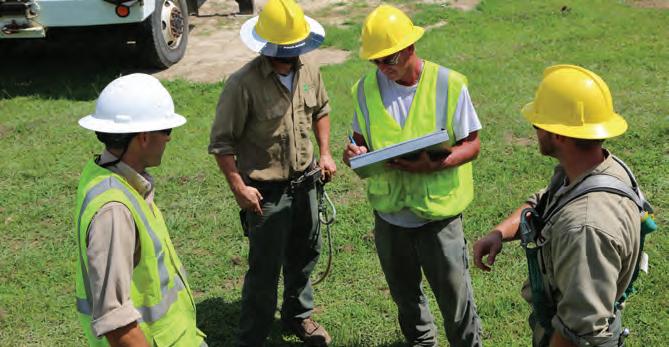
Fall is in full swing, and that means the leaves are changing, the weather is crisp and the holiday season is just around the corner! But the fall season also brings a higher risk of home fires and electrical safety hazards. Read the safety tips below and use the clues to complete the crossword puzzle. Check your work in the answer key.
1 Across: An _____ should always be in the kitchen when something is cooking.
2 Across: Keep any items that can burn away from the stove, _____ and other cooking appliances.
3 Down: Candles and _____ should only be used by adults.
4 Down: Make sure all _____ are blown out before leaving a room.
5 Down: Smoke _____ should be tested every month to ensure
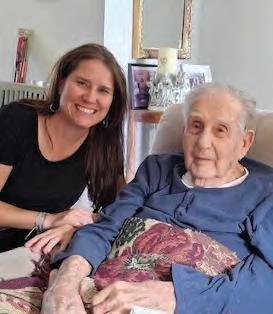
Thankful for my Papaw who celebrated his 99th birthday this year. SUBMITTED by Rachel Brimer, Hamilton.



I am thankful for my family! The love and support of a family is our greatest blessing. SUBMITTED by Gwen Windham, Robertsdale.
So thankful for my grandchildren, Caraline and Cameron Carr. SUBMITTED by Allisyn Parsons, Lineville.
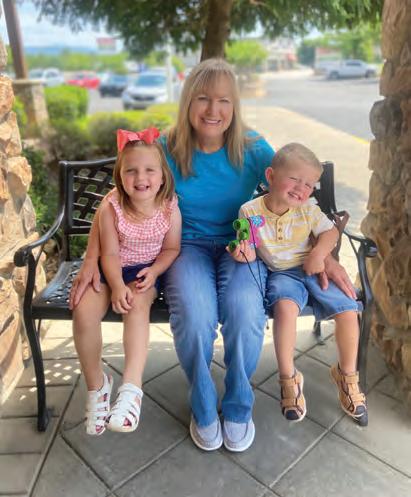
January theme: “Alabama Wildlife” | Deadline: November 31
Submit photos at alabamaliving.coop/submit-photo or by scanning the QR code. Photos submitted for publication may also be used on our website and on our social media pages.

W.C. Handy is Born
William Christopher Handy ranks among the great musical forces of the 20th century. As a musician, songwriter, producer, folklorist and self-proclaimed “Father of the Blues,” Handy is credited with bringing the musical genre into the mainstream.

Handy was born on Nov. 16, 1873, in Florence, Lauderdale County. He came from a prosperous family, the son and grandson of prominent ministers in the African Methodist Episcopal denomination. He honed his musical skills singing and playing hymns in church. Beyond the sanctuary, he sought out music halls and other secular venues, much to his father’s chagrin.
Before his 19th birthday, Handy was writing and performing music in a variety of genres. In his 20s, he earned a teaching degree and served briefly as a music instructor at what is now Alabama A&M University. But it was on the road, not the classroom, where he plied his trade, at venues in Kentucky, Indiana, and Mississippi and in faraway Canada and Cuba. In 1905, he settled in Memphis, the Tennessee city closely associated with the blues.
Handy co-founded a popular music publishing company in 1913, arranging blues and spiritual music for a variety of singers. His autobiography, Father of the Blues, was published to acclaim in 1941. Two years later, an accident on a Harlem subway left Handy permanently blind. He continued to work and publish until his death in 1958 and was a television fixture, appearing as a frequent guest on The Ed Sullivan Show.
Handy’s likeness, trumpet in hand, graced a postage stamp in 1969. Statues of him stand in both Memphis and his hometown of Florence, where his birthplace stands as a museum and an annual music festival is named in his honor.
– Scotty Kirkland
Our little hidden piggie in October attracted a lot of reader response, more than 500 submissions, in fact! He (or she) was perched in the photo on Page 16 of the Mentone Fall Festival, “enjoying some finger-picking music and hoping no one is thinking about having ham sandwiches for lunch,” writes Alice Mullins of Danville, a member of Joe Wheeler EMC. Danielle Gravley of Georgia picked up a copy of the magazine at one of our Alabama Welcome Centers, and noticed that “this piggie’s mother did not teach it to not stare at the people sitting behind him at church, ha ha!” Kim Gilligan of Talladega and Coosa Valley EC expressed similar sentiments: “She looks like a toddler in church turning around to see who’s singing so bad, ha!” And Rachel Miller of

Letters to the editor
E-mail us at: letters@alabamaliving.coop or write us at: Letters to the editor 340 TechnaCenter Dr. Montgomery, AL 36117
My wife and I just read your “The Nickel Hamburger Moment,” (“Cup o’ Joe,” October 2025) . We have to tell you we thoroughly enjoyed it but afraid it hit too close to home!! Great writing and hope to see more. Nice to have a good chuckle! Good health to you.
The Holloways, Cullman
Enjoyed your “Nickel Hamburger” article. For sure I remember the Jack’s jingle on the Cousin Cliff Holman Popeye show: “Jack’s hamburgers for 15 cents they’re so good, good, good.” 15 cents today won’t even pay the tax on a burger!!
Speaking of eggs?? Last shopping trip to Publix I passed the egg section and kept right on walking. End of the aisle is the pharmacy and there’s a blood pressure monitor chair. Thought to myself: What a crazy place to expect a normal blood pressure reading!
Robert Patrick, Munford
As a child we were given 35 cents to spend a whole Saturday afternoon at the Enzor Theater in Troy. It cost a dime to get in. That left a whole quarter to spend on eats. For a quarter one could buy a fountain drink, a bag of popcorn, and a piece of candy. We always got that caramel kind on a stick that would last a long time. We would see a news reel, a cartoon, an exciting serial of “Batman” or “Superman,” which ended each week with the hero having the walls closing in on him or other such horrible circumstances, and two regular movies. One was always a Western. Once Johnny Mack Brown came to the Enzor Theater to grace the Pike County fans. He was a Western hero from Dothan originally. The last movies I saw were “E.T.” and some movie about a black stallion. I just watch TV these days. In fact, the closest theater is in Enterprise or Montgomery. I guess it’s true that the older we get, the more things change!
Gayle Jordan, Troy
Clanton spoke for many readers in her note: “In a life full of craziness and chaos, thanks for a little game to look forward to each month!” Congratulations to our randomly drawn winner, Cindy Holmes of Goshen, who wins a gift card from our sponsor, Alabama ONE Credit Union.
In recognition of Veterans Day, November 11, we’ve hidden these veteran’s boots somewhere in these pages but remember, it won’t be in an ad or on pages 1-8. Good luck!
By email: dingbat@alabamaliving.coop By mail: Find the Dingbat Alabama Living 340 TechnaCenter Dr. Montgomery, AL 36117

Sponsored by


Identify and place this Alabama landmark and you could win $25! Winner is chosen at random from all correct entries. Multiple entries from the same person will be disqualified. Send your answer with your name, address and the name of your rural electric cooperative, if applicable. The winner and answer will be announced in the December issue.
We’ve enjoyed seeing photos from our readers on their travels with Alabama Living! Please send us a photo of you with a copy of the magazine on your travels to: mytravels@alabamaliving. coop. Be sure to include your name, hometown and electric cooperative, and the location of your photo. We’ll draw a winner for the $25 prize each month.
Ann Harris and Martha Mosteller, members of Cullman EC, traveled to Morocco last November. This picture was taken in the Sahara Desert at sunrise.

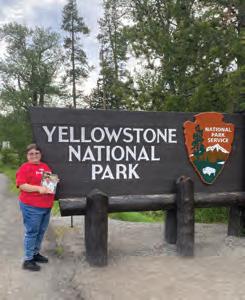
Jo Britton of Stevenson traveled to Yellowstone with her magazine. She’s a member of North Alabama EC.
Becky Vest Perry traveled with Temple Baptist Church of Cullman on a mission trip to Cambodia. A member of Joe Wheeler EMC, she lives in the Oakridge Community.
Submit by email: whereville@alabamaliving.coop, or by mail: Whereville, 340 Technacenter Drive, Montgomery, AL 36117.
Contribute a photo you took for an upcoming issue! Send a photo of an interesting or unusual landmark in Alabama, which must be accessible to the public. A reader whose photo is chosen will also win $25.


Glenda Berry and her granddaughter Lily Jackson of Foley went on a cruise to Cozumel, Mexico to celebrate the birthday of her husband Charles last year. They are members of Baldwin EMC.

Dianne Harris and Kathy Naylor, members of MarshallDekalb EC, took their Alabama Living to Switzerland on their tour of four countries, which also included Italy, France and London.

October’s answer: The Old Depot Museum is located at the old L&N Railroad Depot at the end of historic Water Avenue in downtown Selma. The Depot building was built on the site of the Confederate Naval Foundry which was destroyed by Federal troops during the Battle of Selma in 1865. The red brick, stone trimmed building of Romanesque Revival architecture was built ca. 1890. It is one of 12 railroad depots in the Southeast designated by Southern Living to be of architectural and historical importance. (Photo and information from Welcome to Rural SW Alabama; RuralSWAlabama. org) The randomly drawn correct guess winner is Stephen Moon of Tallapoosa River EC.
Keith and Lori Hensley of Danville, and Sheila McCaig of Hartselle, all of Joe Wheeler EMC, traveled to upstate New York and Niagara Falls last year. They were photographed in front of Horseshoe Falls from the Ontario, Canada side.






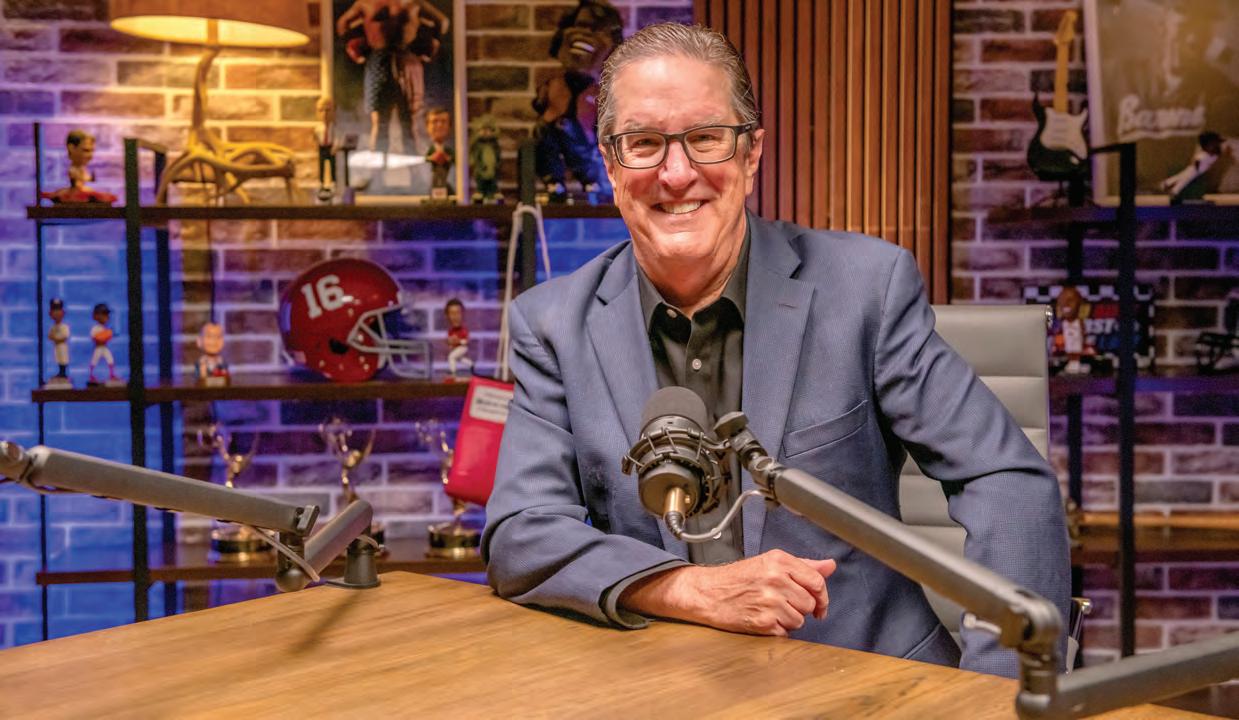
Oninitial observation, one might think this is a television studio, a radio station, or communication center. Cameras, boom mics, and video screens dominate the office suite overlooking Jefferson County.
Phones are turned to silent mode, and non-essential personnel are gently reminded to remain quiet as one of Alabama’s most familiar voices speaks into the mic. “Hello everybody, welcome back. This is ‘The Good Company Podcast’ and I’m Rick Karle.”
Karle’s “Good Company” podcast co-hosts include longtime TV and radio anchor Matt Coulter, New York Times best-selling author Lars Anderson, and regular special guest James Spann.
For Karle, “podcast host” is his latest title in a career spanning over four decades.
Many know him from his 43 years in broadcasting. His resume includes news and sports broadcasting from New Hampshire, Florida, and Alabama. In the Birmingham area, he became a household name, working at WBRC TV for 30 years, followed by morning co-hosting and anchor desk positions at WTVM13.
To say the least, he is good at what he does.
Karle has accumulated an array of recognition including 25 Emmy awards. His career also earned him the honor of “Best Sports Anchor” by the Alabama Broadcasters Association. He is also the recipient of the Edward R. Murrow National Award for reporting, and he was inducted into the Alabama Sports Hall of Fame in 2023.
With self-effacing humor, he responds to the accolades bestowed upon him. “These awards prove that I’ve been around a long time,” he smiles. “It also helps when your parents are on the judging panels.” News update: Karle’s parents were not on the judging panels.
Born in Syracuse, N.Y., Karle began his career as a sports director for WNNE in Hanover, N.H. It is where he met future wife, Jill, then a registered nurse. They married in 1984 and have two children, ages 27 and 24.
In 1989, after a sports anchor job for WJXT TV4 in Jacksonville, Fla., Karle ventured to Birmingham’s WBRC TV. He replaced Eli Gold, who had accepted the play-by-play position for the University of Alabama football broadcasts.
In the early 2000s, social media was growing by leaps and likes. “Our TV managers wanted their news and sports anchors to be involved with it,” Karle recalls about social media’s infancy. “I had writing experience. As a sportscaster, I wrote scripts all the time. You just pound it out.” Moving those skills to social media posts was a smooth transition for him.
“I did not realize until about 5 years ago how much I enjoyed writing,” he recalls.
Leveraging new platforms
Karle “sort of” retired in 2023, but his social media venture did not. Thus, the advent of Rick Karle Good News, available on Facebook and beyond. The sportscaster turned blogger has a Facebook following of over a half million people and growing.
His unofficial mission statement is the key to his success. “I do not want to be the bearer of bad news,” he says. “I want to

be the bearer of good news, even in the midst of bad news.” He continues, “I like giving people the attention they deserve and otherwise would not receive. There is so much good out there, but you don’t see it. You turn on the news and see a lot of terrible things. I stay away from that on my page.”
Topics include rescues, heroism, good deeds, triumph over adversity, victory over tragedy and overcoming illnesses. Not all of his posts are happy, but most have at least an element of positivity. He adds, “I try to find the good regardless of how bad the situation is.”
As an example, he recalls, “A mother wrote a devastating letter to me about her child with cancer. In addition, she is broke and might lose her house. She wanted me to write about it, but I wondered how I could include good news in the story.” He found a way.
“I discovered her ill son loved fire trucks and was able to ride in one and even in the midst of his battle, he was bringing inspiration to others. I covered the story from that angle – a ray of good news in a difficult situation.”
He adds, “Typically, I feature good deeds, good news –stories with something uplifting in them. I wrote about a rescue dog who was burned but is now getting better. People like positive stories these days.”
Karle also shares his life. “On occasion I write about my family. We recently lost our Yorkie. I wrote about how painful that was. People can relate to that. I try to write what people relate to.”
Karle will write about all subjects, even his kitchen table. “It is old and from the 1800s, a scuffed up old table, but it holds so many memories,” he says.
Rick Karle Good News’ audience started in Birmingham and has spread to Florida, Tennessee, Texas, and beyond. “I will write stories from anywhere if it’s a good story,” he notes. “There is good news in Michigan, Florida, California, and North Dakota – everywhere.”
As for the writing process, discipline is the key. Karle writes 3 to 5 posts a day, every day. Sometimes he posts up to 10 a day. They range from one or two sentences to full essays.
“It can intrude into your life but not if you plan it right,” he added. “Typically, my daily posts start the night before. During the evening and night, it is me, my laptop, and late night TV. I can knock out three or four posts a night.”
There is a never-ending content supply. Karle receives 3 to 15 post requests a day through email, messaging, and cell phone calls. He also searches for story ideas, not just for Facebook but also his latest venture, the Good Company Podcast.
The new podcast features interviews with people from all walks of life. “We want to get behind the people we interview. We want to tell our viewers and listeners something about our guests, the audience may not know,” he says.
He adds, “For example, everybody knows Coach Nick Saban’s football legacy. If we ever landed an interview with the coach, we’d like to talk to him about growing up in West Virginia, meeting Miss Terry back in the 7th grade, and working at his dad’s filling station.”
Today’s guest is Ben Abercrombie, a former Hoover High School football standout who was paralyzed with a spinal cord injury during his first football game as a player for Harvard University. Abercrombie vowed to graduate from Harvard and years after he was paralyzed from the neck down, he did. Karle draws out the miraculous story.
“I love Rick’s love for people,” co-host Matt Coulter says about Karle. “It is perfect for a podcast called ‘Good Company.’”
Co-host Lars Anderson adds, “We are on the cusp of something very special. We hope to remain local but also be listened to around the country.”
With the podcast complete but a blog post due, Rick Karle returns to work. He is fueled by the desire to inform with positive content.
“People are hungry for good news,” he says. Somebody has got to bring it to them. “It might as well be me.”
Rick Karle can be found on Facebook at Rick Karle Good News and on the Good Company Podcast on YouTube and wherever podcasts are available.
Rick Karle featured one of our Alabama rural electric cooperative employees in his Sept. 9 Facebook post, spotlighting Reed Crosby, a healthy 28-year-old Pioneer Electric Cooperative employee, whose heart stopped 75 times in 48 hours.
On Aug. 25, Reed, the co-op’s AMI/SCADA technician, passed out at his desk at the co-op office in Greenville and was taken to a local emergency room. He was quickly airlifted to Baptist Medical Center South in Montgomery, where he coded several times during a heart catheterization before being sent to UAB Hospital in Birmingham. Realizing he was in V-Fib (ventricular fibrillation), doctors performed an ablation to remove dead heart tissue. While there he coded 56 more times. All told, his heart stopped 75 times.
“Reed was sedated for 8 days and put on a ventilator,” Karle wrote. “Then came together wonderful doctors and modern medicine.” He was fitted with an internal defibrillator (which detects heart stoppage and shocks it back into functioning) and a pacemaker, and amazingly, was able to go home on Sept. 9. He returned to work at Pioneer Electric on Sept. 29.
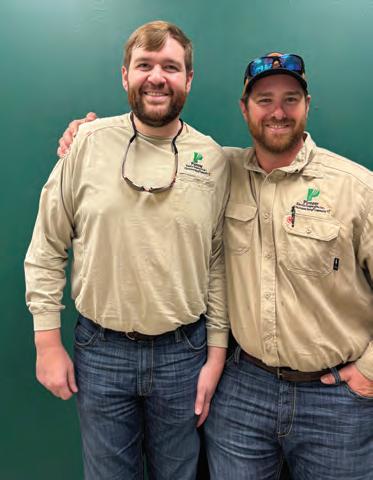
how strong I am, but I’m not. God is.”



Andy and Marianne Whitehead, members of Joe Wheeler EMC, started shipping their roasted fig beverage from their Huntsville headquarters in 2021. Their figs, shown oposite page, are sourced from the Mediterranean area, but they’ve also started growing a few fig trees on their property in Eva. “They’re remarkably easy to grow,” says Marianne. “It’s a race to see if I get there before the birds do.”
BY LENORE VICKREY
Acouple of years ago, while browsing a spring crafts show in Birmingham, Jennifer Pierce was looking for a warm drink to sip when she stopped at a booth offering samples of a beverage she’d never heard of. It was a coffee made from -- of all things -- roasted figs.
“I fell in love with it,” she says. “It tasted like coffee, and then I learned how healthy it was. I became a huge fan.”
The beverage was FigBrew, roasted and ground in Huntsville by founders Andy and Marianne Whitehead, members of Joe Wheeler EMC. The couple has been making their unique blend for five years and seen steady growth in their clientele every year. “We sell it as both a coffee replacement and as a coffee supplement or additive,” Andy says.
Why figs? “I love coffee but it doesn’t love me back,” says Andy, a coffee lover since he was 12. He came up with the formula for their popular product while searching for an alternative that he would like and that Marianne, a tea drinker, would also enjoy. While doing research, he learned that during World War II in England, roasted fig was mixed with coffee to extend its life.
Fig-based beverages went back even further, he learned. “Roasted fig as a beverage has been around for hundreds of years. In 1873 there were 20 factories that made roasted fig as a beverage,” he adds. “Vienna had a worldwide reputation for their coffee houses in part because they mixed fig in it.”
After some experimenting, Andy landed on a formula that held up when mixed with regular coffee and eliminated some of coffee’s adverse effects. “It enhances the flavor of whatever you mix with it,” he says. “It’s alkaline, high in potassium, and low in sodium so it helps regulate blood pressure.
“More than half our customers come to us because of digestive issues. There are three things people have issues with, especially older folks like me who love coffee -- heart arrhythmia, high blood pressure and gastric reflux. And so when the doctor says cut back on coffee, that’s hard to do. But by replacing a portion of your coffee with ground fig, you can micromanage that coffee intake.”
Their figs are sourced from Mediterranean countries, primarily Turkey, Spain and Greece, and are grown “by people who’ve grown them for years and earn an honest wage,” says Andy. (In the U.S., figs are grown commercially only

in California, he explains, “and those are the mission figs that the Spanish introduced 300 years ago. They’re good for eating but not for our purposes.”)
Then they are slow-roasted at a lower temperature than is used for coffee beans, caramelizing the fructose in the fig and creating a slightly sweet taste. “A lot of people who take sugar and milk in their coffee find they don’t have to with roasted fig because it’s still slightly sweet,” says Andy. The figs are then cooled, processed and ground in a commercial coffee grinder for packaging in biodegradable bags or single-use pods.
The pair began shipping their first batches in January 2021 and spread the word about their new product by offering samples at coffee shows around the country. People took notice. “They would say, ‘You’re the best thing at the show,’ ” says Marianne. “We were like, ‘Wow!’ It was unexpected.”
“ There’s nothing else like it and it brews just like coffee,” adds Andy.
FigBrew has since won awards at several coffee shows, including “Best of Show” at the largest coffee show in the Midwest. Most recently it took top honors at the October NOLA Coffee Show in New Orleans, winning first place in the decaf category for its Morning Prebiotic Blend, a new brew flavored with mesquite and date seeds.
The Whiteheads sell their products in select supermarkets on both U.S. coasts and in the Midwest, but the majority of FigBrew’s sales are via their website and on Amazon. Some devoted customers will drive an hour to their office in Huntsville to replenish their supply. Many, like Fay Leo of (cont. pg. 20)

There’s good news for Alabamians living with limited income and resources. The Medicare Extra Help program—also known as LIS—expanded in 2025. If your income is below 150% of the federal poverty level, you may now qualify for full Extra Help benefits. This means you could pay lower or no premiums, reduced Part D drug copays and reduced or no Part D deductible for your prescriptions. Many people don’t realize they’re eligible—so it’s worth checking.
For example, in 2025, individuals earning less than $23,475 per year (or couples earning less than $31,725 per year) may qualify as long as your assets are below the specified limits. You could save hundreds of dollars each year on the medications you rely on!
To see if you qualify for Extra Help, call: The Social Security Administration at 1-800-772-1213, between 8 a.m. and 7 p.m., Monday through Friday. TTY users should call 1-800-325-0778.
Medicare can be complex, and it’s normal to feel uncertain with so many parts and plans to consider. Blue Cross and Blue Shield of Alabama understands this and offers Medicare plans grounded in decades of experience and trust. For generations, Blue Cross has been a steady partner for individuals and families, providing coverage that gives you confidence and peace of mind as you navigate your healthcare choices. With a name you can depend on, you can feel secure making important decisions about your health.

Selecting the right Medicare plan is a crucial decision, and it’s important to consider several factors to ensure the best fit for your needs. Here are some considerations to help you decide:
Is your doctor in the plan’s network?

What will your prescription costs be?
What are your overall monthly expenses?
Are you covered when you travel?
Are there extra benefits like dental, vision and hearing?
Understanding that every individual has unique healthcare needs, Blue Cross offers a variety of plan options to ensure that you find the right fit:
• A Part C Medicare Advantage plan
• Offers all-in-one coverage
• Combines medical and prescription drug benefits with extras like vision and dental
With almost 90 years of experience, Blue Cross and Blue Shield of Alabama offers trusted healthcare coverage. Our extensive network includes 90% of doctors and 100% of hospitals in Alabama,1 providing top-tier care statewide. We offer comprehensive plans that cover medical expenses, prescription drugs and include additional benefits like dental, vision and hearing.
Our commitment to quality is reflected in high customer satisfaction and ratings, with Blue Advantage plans earning 5 stars for “Member Experience with Health Plan” and 4 stars overall in 2025.2 Our emphasis on customer service ensures you’re never alone in navigating your healthcare options.
Choosing Blue Cross means peace of mind, with local resources and straightforward plans designed to make your Medicare journey simple and easy.
• A Medicare Select Plan or type of Medigap Medicare Supplement plan
• Provides fewer out-of-pocket costs for Medicare-covered services
To get more information or talk to a local advisor, call 1-877-235-4080 (TTY 711) or visit BCBSALMedicare.com/Blue11, 8 a.m. – 8 p.m. CST.3
• A Medicare-approved Part D plan
• Pairs with C Plus or Original Medicare
• Helps pay for prescription drugs
Huntsville, are on an automatic shipping plan, receiving two pounds of her favorite Figgee blend every 6 to 8 weeks. She first tasted it at a Christmas show in Huntsville where they were giving out samples. It only took one taste and she was a fan.
“I use it every morning, half Figgee and half regular coffee,” she says. “I love my coffee but every morning I mix it with Figee. I tell my friends about it.” She even packs FigBrew when she travels. “When I have coffee that doesn’t have it, I miss it,” she says. “It’s a deeper, richer flavor.”
Customers like her and Jennifer Pierce are FigBrew’s prime demographic, Andy says, “because they are the ones who typically buy for the household.” But now a younger crowd is interested “and they’re asking questions about how coffee is grown, how the workers are treated, are they paid a fair wage, is it organic and so on.”
The Whiteheads are committed to producing a product that is sustainable. “Fig uses 1/8 the amount of water to make a cup of fig coffee, compared to traditional coffee,” says Andy, “and 1/13th of the carbon footprint. Coffee trees put out 1½ to 2 pounds of coffee a year, while a fig tree puts out between 40 and 60 pounds of figs per year.” Figs have 20 to 30 times the production capacity than does coffee. “If you drink
a cup of coffee every day, you consume the output of 10 to 15 coffee trees. It’s a huge resource.”
These kinds of statistics are important because “the current coffee culture is unsustainable,” Andy states bluntly. Factors like climate change, disease and deforestation are combining to attack the coffee crop, driving prices up to a 50-year high. But rather than see coffee growers, some of whom are indigent farmers with a small piece of land, go out of business, “we intend to help the coffee culture be more robust and productive,” he says. FigBrew “is something that enhances what they offer, makes it healthier and more sustainable.”
As the popularity of FigBrew grows, the Whiteheads look to a future where it will be on store shelves alongside Folgers and Starbucks.
”My goal is to recreate the coffee culture in its entirety,” says Andy. “Everywhere coffee is sold, we want to be sold -- in grocery stores, coffee shops, wherever and in whatever form, we think roasted fig has a place.”
Special limited time offer for Alabama Living readers: FigBrew is offering 25% off any online order on their website with the code Alabamaliving. Offer valid Nov. 1-30. Read more about Figbrew at figbrew.com, or visit their Huntsville office at 3104 Leeman Ferry Rd SW, Huntsville, AL 35801.





puts an elevated spin on traditional café
STORY AND PHOTOS BY JENNIFER KORNEGAY
For years before she opened Fort Payne’s The Bakehouse Downtown in 2022, owner Crestah Taylor taught elementary school. And while she still owns and oversees the combo coffee shop, bakery and cafe, she returned to the classroom this year.
Yet, she was always instructing others and still is, even when she’s not in school, teaching her team and her customers why quality matters and how hospitality works by her example.
But it all started with cookies and coffee. “I love baking, and when my kids were little, I made and decorated cookies for parties and showers on the side,” she says. As she and her family traveled the country, she discovered a love of good coffee and the cute, comfy coffee shops that served it, too. When she saw a vacant building in downtown Fort Payne, she didn’t overthink the idea that struck.
“It was kinda a whim, but I just decided I wanted a bakery and coffee shop of my own, a place where people would come and relax and enjoy really good things,” she says. The space needed a lot of TLC; Taylor recalls it was merely “a hole.” But a blank canvas provided her a chance to create what she envisioned when the inspiration first struck.
Today, The Bakehouse’s bright white interior and its minimalist yet inviting decor welcome guests: Those who pop in to grab a flaky chocolate croissant, and others who snag a window seat and tuck into a cinnamon dulce latte with a book, a friend or their laptop.
And there are those who order fried-egg-topped breakfast bowls filled with crisp roasted potatoes, black beans and cheese in the morning, or come midday, one of the Bakehouse’s lunch options, like the Figgy, with smoked turkey and sharp white cheddar tucked between slices of whole grain bread slathered with fig jam, or a grilled cheese (packed with smoked gouda, sharp white cheddar and caramelized onion jam) begging to be dunked in creamy tomato bisque. A wrap stuffed with turkey, bacon and shredded Colby jack, plus seasonal items like the strawberry-spinach salad in spring or apple-walnut salad in autumn round out the selections.
Taylor’s eye and palate-pleasing iced cookies are often available too. And dietary restrictions don’t stop fans of The Bakehouse. Many of its salads and soups are glutenfree, gluten-free bread is available by request, and Taylor tries to keep at least one gluten-free pastry or muffin in the rotation as well.
Each autumn brings a new reason to fall for The Bakehouse. In October, it began opening at night on Thursdays, serving a single-dish dinner, like big bowls of hearty, homey cheese tortellini soup, with sourdough toast and a chopped salad on the side and sea-saltcaramel brownies for dessert. (Watch The Bakehouse’s social media for dates and menus.)























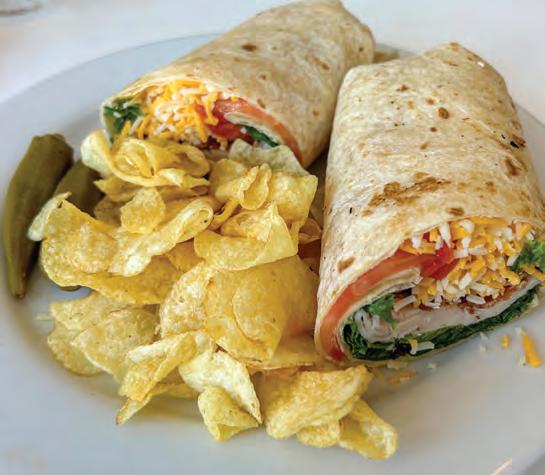
Taylor explains the motivations behind the menu. “Everything has some kind of spin on it, like serving pickled okra spears with sandwiches instead of a traditional pickle.” Every item is Taylor’s own recipe or her twist on something she’s eaten and enjoyed at other cafes. She discovered the Bakehouse’s DOMA coffee on a trip to Zion National Park. She visited the northern Idaho-based company’s “coffee lab” before opening, where she learned to create The Bakehouse’s flavoring syrups — vanilla, coconut, cinnamon and more — that get stirred into specialty coffee drinks, which change with the seasons.
The common threads are commitment to quality and Taylor allowing her perfectionist streak to lead the way. “The key things for me are good ingredients and homemade,” she says. The Bakehouse makes its own soups and sauces from scratch and bakes all pastries fresh daily. Housemade herb mayo embellishes sandwiches. The breakfast sandwich with bacon, scrambled eggs and gouda gets a kick from housemade sriracha aioli and tang from housemade pickled onions.
Taylor’s team delights in the details too, taking the time to go through extra steps, like cold-steeping organic looseleaf teas for 24 hours to deliver big bold flavor. “I have a great manager, and we are all a big family,” she says. “I’m really particular; I want everyone who comes in here to leave really happy, and my team helps me achieve that.”
Their skill and adherence to Taylor’s high standards made it possible for her to return to her other love — teaching — with zero trepidation. Downtown Fort Payne also garners her affection. She and her kids live in an old craftsman-style house they renovated downtown. “I love living down here; I love just walking around,” she says. When The Bakehouse opened, there weren’t many other businesses to stroll to, but downtown now boasts a boutique, a spa and a wine bar, with a flower shop and yoga studio opening soon.
“I’m proud to play a role in the revitalization,” Taylor says. She’s equally thrilled to note a distinction in the downtown’s renaissance. “This entire street is all womenowned businesses, except for a game store, but the owner’s wife helps, so I think that counts too,” she says.
Now several years in, Taylor looks back and believes she’s hitting the goal she set. “It’s a small space, but it’s built on quality in what we serve and a welcoming vibe that entices people to just come hang out,” she says. “I love watching people come together here.”
The Bakehouse Downtown
110 1st St. W, Fort Payne, AL 35967
256-979-1481
facebook.com/tbhdowntown/
Hours: 8 a.m. to 2 p.m. Monday-Friday
9 a.m. to 2 p.m. Saturday Closed Sunday




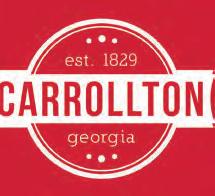
















This winter, glide into a wonderland of fun at Carrollton on Ice, our new covered outdoor ice rink! Skate, twirl and laugh with your family and friends beneath a canopy of twinkling lights, whatever the weather. Warm up with a hot cocoa or snack from a food truck every Friday and Saturday. Create altogether unforgettable memories and enjoy the magic of the season with us! For more information, visit carrolltonga.com/iceskate


DEC 13 NOV 14
DEC 4-7 THROUGH
SMALL PACKAGES GIFT EXHIBIT
RUDOLPH THE BALLET
COMMUNITY THEATRE: ALL IS CALM: THE CHRISTMAS TRUCE OF 1914
DEC 6 DEC 13 DEC 16
MERRY MARKET & CHRISTMAS PARADE
COMMUNITY CHORUS & CARROLL SYMPHONY ORCHESTRA MESSIAH - CHRISTMAS IN CARROLLTON CONCERT
WIND ENSEMBLE CHRISTMAS CONCERT
DEC 19 DEC 19
CHRISTMAS WITH THE CARROLLTON JAZZ ORCHESTRA
CHRISTMAS VACATION MOVIE NIGHT AT THE AMP
EVENT CALENDAR
carrolltonga.com/events
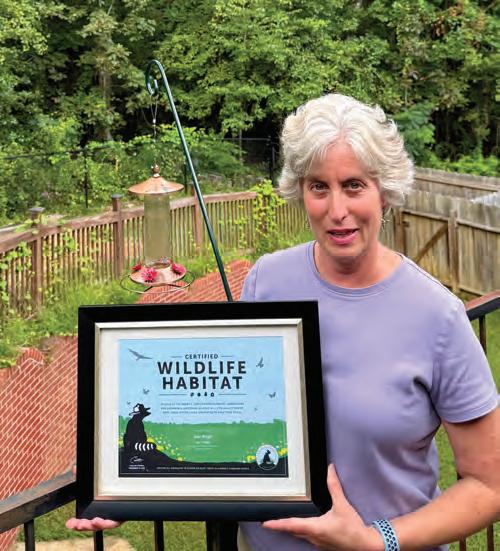
For Joan Wright, the decision to create a welcoming habitat for wildlife and an inviting space for native plants and trees came … well, naturally.
Wright and her husband, Carl, who are members of Coosa Valley Electric Cooperative, have had their property certified by the National Wildlife Federation as an official wildlife habitat. Such habitats provide natural sources of food, water, cover and places for wildlife to raise their young, and are maintained in a sustainable way that incorporates native plants, conserves water and doesn’t rely on pesticides.
Joan says one of her favorite things to do is to sit on the deck of their home and look over the backyard, which is surrounded by woods. She got involved with the NWF through the Wild Birds Unlimited store in Hoover, her favorite place to shop for birdseed for the feeders in her yard. After she learned about the program and gave it some thought, she filled out a quiz from the NWF along with some information about her home and environment, and they sent her a certificate.
“I create spaces and natural items that can draw animals to a place, where they can live and grow and beautify our area,” she says.
Her favorites are birds – she can have as many as 15 hummingbirds a day in her four feeders – but they also have hawks, mourning doves, bluebirds, finches and cardinals, in addition to foxes, deer, rabbits, butterflies and “lots of little bees.”
Being outside extends to the Wrights’ vacations as well. “We enjoy the outdoors as a family,” she says. “When we go on trips and vacations, we’re usually looking for adventures that are outside. We do kayaking, canoeing, river floats, hiking and fishing.”
In addition to providing a safe environment for animals, certified habitat homeowners promote natural, native plants, and work to keep out such invasive species as kudzu and privets.
“Find out what kind of plants, flowers, trees and shrubs are native to your area,” Joan says. “Plant those, because that’s what’s going to be better for the wildlife habitat – that they have vegetation, shrubbery and places to eat, house, nest, protect themselves and their young from predators.” She suggests working with local gardening clubs or master gardeners to get started.
The NWF also encourages the limited use of pesticides and herbicides. In the Wrights’ backyard, rather than putting down plastic landscaping barriers or weed killers, which can be harmful to water sources, Joan takes old cardboard boxes, breaks them down and uses them as a weed barrier in flower beds.
“It doesn’t cost me anything. It’s not putting chemicals into the soil. (Those) eventually go into our runoff water and affect the plant habitat, which affects the animals’ habitat,” Joan says.
She continues to add to her landscape. A neighbor is preparing to do an expansion of her home, which will require the removal of many native plants. Joan asked if she could dig them up and bring them to her own property instead of throwing them out. “They can come to my property and continue to be enjoyed and provide places where (wildlife) can prosper.”
She says that homeowners don’t have to have acres and acres of land in the middle of nowhere to create their own personal wildlife preserve. Even a small piece of property can become a wildlife paradise.
“ That’s really what the NWF is about,” she says. “They want to encourage people to foster these natural habitats in their own communities, in their own yards.”
For more information about the program, visit nwf.org/garden, and follow the National Wildlife Federation’s social media channels on Facebook and Instagram.


















































BY MYLES MELLOR

THROUGH NOVEMBER 9
Dothan, National Peanut Festival, 5622 U.S. 231 South. Amusement rides, fair food, agriculture exhibits, demolition derby, horticulture, photography and cooking contests, petting zoo and animal activities for children and music performances from Shenandoah, Anne Wilson, Baylee Bennett Knighton and Vincent Mason. NationalPeanutFestival.com
NOVEMBER 1
Pike Road, Pike Road Arts and Crafts Fair, 9 a.m. to 4 p.m. at the historic Marks House. Diverse types of quality art and craftwork, food, children’s activities and shopping just in time for the holiday seasons. Admission $5; children 8 and under are free. Cash only. Pikeroadcraftfair.com
NOVEMBER 1
Demopolis, Vine and Olive Festival, presented by Main Street Demopolis at the public square. Wine tasting, antiques, art, live music, children’s activities, food vendors, pop-up shops and more celebrate the area’s French heritage. Admission is free; wine tasting is $25. Search for Main Street Demopolis on Facebook and Instagram.
NOVEMBER 5-8
Wetumpka, Frontier Days at Fort Toulouse Jackson Park, 9 a.m. to 4 p.m. Adults $15, students $10. Re-enactors depicting Creek Indians, French soldiers and their families and British traders demonstrate life on the Southern frontier during the 18th and early 19th centuries. Strolling balladeers, entertainers, period musicians and a magician as well as merchants selling quality reproductions of period items. FtToulouseJackson.org
NOVEMBER 8
Fort Payne, Creative Spirit Market, DeSoto State Park, 10 a.m. to 3 p.m. Unique open-air art fair features locally and regionally made fine and folk art, handcrafted goods, live artist demonstrations, live music and interactive art stations for kids and adults. Free. Rain or shine event. Limited parking in the picnic area, the tennis court area and in front of the Country Store. Bring chairs to enjoy music. 256-997-5025.
NOVEMBER 8
Collinsville, Historic Turkey Trot, 10 a.m. to 3 p.m. in the downtown area. Food, games, antique car and tractor show, turkey shoot, cake walk and a “turkey toss” from a rooftop make this fun for all ages. 256-524-2788.
NOVEMBER 13-16
Fairhope, 13th annual Fairhope Film Festival. Award-winning films, exclusive parties and panels of film industry professionals will be featured in the scenic downtown area. See fairhopefilmfestival.org for the latest updates on scheduled showings.
NOVEMBER 14-16
Springville, Homestead Hollow Arts & Crafts Festival, fun for the whole family! Arts and craft vendors, kids’ activities, pioneer demonstrations, live entertainment and food. Adult admission is $10, and free for kids 12 and under. Free parking. homesteadhollow.com
NOVEMBER 15
Wetumpka, Holiday Open House in downtown, 10 a.m. to 6 p.m. Get a head start on holiday shopping at this event hosted by Main Street Wetumpka. Search for the event’s page on Facebook.
NOVEMBER 15
Clanton, Peach Orchard Christmas Market, hosted by the Chilton County Arts Council. 9 a.m. to 3 p.m. at the Clanton Performing Arts Center; free admission. Indoor market with handcrafted items and unique gifts. ChiltonCountyArtsCouncil.com
NOVEMBER 15
Cullman, The Christmas Market, Cornerstone Revival Center at 3151 Highway 69 North. 10 a.m. to 4 p.m. Forty vendors, food trucks, a photo booth, bounce house and more. Free. Crccullman.com
NOVEMBER 20
Cullman, Tinsel and Timber live and silent auction, 6 p.m., The Venue at Cotton Creek, 417 Third Ave. SW. Decorated Christmas trees, décor and unique gifts. Festive cocktail attire; heavy hors d’oeuvres and holiday drinks. Proceeds benefit First Source for Women. info@firstsourceforwomen.org
NOVEMBER 22
Demopolis, second annual Joyeaux Market on the public square. Handmade décor, food, music and more. Search for Main Street Demopolis on Facebook and Instagram.
NOVEMBER 22-23
Montgomery, Whoville Holiday Market, Garrett Coliseum, 1555 Federal Drive. 10 a.m. to 5 p.m. Saturday and 10 a.m. to 4 p.m. Sunday. Shop with more than 175 vendors and have kids’ pictures taken with Santa and the Grinch and more. $7 per person; kids 10 and under free. Free parking. TouchTheSkyEvents.com
DECEMBER 4, 6
Millbrook, City of Millbrook Spirit of Christmas events, Village Green Park. City tree lighting begins at 6 p.m. Dec. 4. Festival hours are 9 a.m. to 4 p.m. Dec. 6, and the parade starts at 2 p.m. This year’s theme is “Santa’s Workshop.” Search for Spirit of Christmas, Millbrook, Al on Facebook.

DECEMBER 5-6
Bay Minette, 43rd annual Christmas Fest, 11 a.m. to 8 p.m. Friday and 8 a.m. to 7 p.m. Saturday, Blackburn Park, 101 N. Hoyle Ave. Arts and crafts vendors, food vendors, kids’ activities, breakfast with Santa, petting zoo, car show, carnival games, stage entertainment and a Saturday night light show following the annual Christmas parade. 251-937-5666 Ext. 1.
6
Henagar, Christmas at the Cabin, Henagar City Park, 18200 Alabama Highway 75. Lighted Christmas parade begins at 4 p.m. and will conclude with entertainment, pictures with Santa, train rides and food from Crossover Cowboy Church. Christmas trees donated by the community will be on display all month. CityofHenagar.com
Dothan, Victorian Christmas, Landmark Park, 1 p.m. Listen to Christmas carols and visit with Santa. Snacks, arts and crafts, music, wagon rides and homemade decorations. A circuit riding preacher will deliver a holiday message. Free; nonperishable donations to the food bank are appreciated. LandmarkParkDothan.com
To place an event, e-mail events@alabamaliving.coop. or visit www.alabamaliving.coop. You can also mail to Events Calendar, 340 TechnaCenter Dr., Montgomery, AL 36117; Each submission must include a contact name and phone number. Deadline is two months prior to issue date. We regret that we cannot publish every event due to space limitations.

Alabama Living on FB instagram.com/alabamaliving

If you’ve ever walked past a beautifully maintained garden and wondered what makes it look so polished and healthy, chances are mulch played a big role. Mulch isn’t just a finishing touch — it’s a powerhouse tool in landscape management. Whether you’re a homeowner, gardener, or land manager, understanding the benefits of mulch can transform how you care for your outdoor spaces.

So, what exactly is mulch? At its simplest, mulch is any material — organic or inorganic — spread over the soil surface. Common types include pine bark, wood chips, straw, shredded leaves, and even shells or gravel. But beyond aesthetics, mulch serves several critical functions backed by research and field experience.
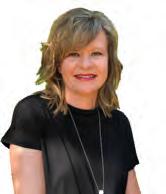
One of mulch’s most important jobs is helping soil retain moisture. According to related studies, mulched soil loses significantly less water to evaporation compared to bare soil. This is especially valuable in hot
climates or during dry spells. By keeping the soil cool and moist, mulch reduces the need for frequent watering — saving time, money, and resources.
Mulch also improves soil structure over time. Organic mulches break down slowly, adding nutrients and encouraging beneficial microbial activity. This natural composting process enhances soil fertility and supports plant health. Think of it as feeding your soil a slowrelease diet.
Weeds are the bane of every gardener’s existence. Fortunately, mulch acts as a natural weed barrier. By blocking sunlight, it prevents weed seeds from germinating. Research shows that a 2- to 3-inch layer of mulch can reduce weed growth by up to 90%. That means less time spent pulling weeds and more time enjoying your landscape.
Mulch acts like a blanket for your soil. In summer, it keeps roots cool; in winter, it insulates them from freezing temperatures. This buffering effect helps plants thrive year-round and reduces stress caused by extreme weather fluctuations.
Mulch also plays a key role in preventing soil erosion. During heavy rains, it helps anchor the soil, reducing runoff and protecting plant roots. Plus, let’s not forget the visual impact — mulch gives landscapes a clean, cohesive look.
To get the most out of your mulch, follow these best practices:
• Clear the area first: Remove weeds, grass, and debris before applying mulch. This ensures a clean surface and better weed control.
• Use the right depth: Apply mulch in a layer about 2–3 inches thick. Too little won’t suppress weeds, and too much can suffocate plant roots.
• Keep mulch away from stems and trunks: Avoid piling mulch directly against plant stems or tree trunks (i.e., volcano mulching; see illustration at left). This can trap moisture and lead to rot or pest issues.
• Refresh annually: Organic mulch breaks down over time. Replenish it each year, rather than fully replacing it, to maintain its benefits and appearance. Mulch is more than a decorative layer — it’s a strategic tool for healthier, more resilient landscapes. From conserving water and suppressing weeds to enriching soil and protecting plants, mulch delivers a host of benefits that make it a must-have in any outdoor space.


Leave a legacy for future generations, nothing embodies this sentiment quite like the enduring gift of gold from American Gold Reserve. With its intrinsic value and historical significance, gold represents stability and prosperity across generations, making it a cherished asset to pass down. Secure your family’s future with a gift that stands the test of time, ensuring a legacy of financial security and enduring value.

American Gold Reserve is releasing Government issued $5 Gold American Eagles completely free of dealer markup for only $369 each. These beautiful $5 Gold American Eagles are a perfect way to enter the gold market. They are set for immediate public release and will sell out fast

• Teach the importance of wealth preservation.
• Great way to pass on wealth to children and grand children.
• A symbolic act of the commitment to your family.
• Gold provides your children and grandchildren with a built-in safeguard during times of financial instability.



Remember when…
Think about the things you loved to do that are dif cult today — going for a walk or just sitting comfortably while reading a book. And remember the last time you got a great night’s sleep?
As we get older, health issues or even everyday aches, pains and stress can prevent us from enjoying life.
So what’s keeping you from having a better quality of life?
Check all the conditions that apply to you.
Personal Checklist:
Arthritis Dry Skin
Insomnia Anxiety
Diabetes Mobility Issues
Lower Back Poor Pain Circulation
Then read on to learn how a
Safe Step Walk-In Tub can help.
Feel better, sleep better, live better
A Safe Step Walk-In Tub lets you indulge in a warm, relaxing bath that can help relieve life’s aches, pains and worries.










A Safe Step Tub can help increase mobility, boost energy and improve sleep.

It’s got everything you should look for in a walk-in tub:
• Heated Seat – Providing soothing warmth from start to nish.
• MicroSoothe® Air Therapy System – helps oxygenate and soften skin while offering therapeutic bene ts.
• Pain-relieving therapy – Hydro massage jets target sore muscles and joints.
• Safety features –Low step-in, grab bars and more can help you bathe safely and maintain your independence.
• Free Toilet















For many of us, Thanksgiving dinner isn’t so much about the turkey, but the homemade dishes that complement it. Most families have traditional dressing (usually the cornbread variety in the South) and sweet potatoes in one form or another, but in this issue, we’re featuring some different side dishes from our readers we think you’ll enjoy trying. Happy Thanksgiving!
6 tablespoons olive oil, divided
2 ½ pounds red potatoes, cut into 1-inch chunks
1 tablespoon kosher salt
1 (1- oz.) dr y ranch seasoning packet, divided
¾ cup sour cream
¼ cup buttermilk or whole milk
Chives or dill, for garnish
Preheat the oven to 450 degrees. Line a baking sheet with foil. Pour 4 tablespoons of oil onto the prepared baking sheet. Place the baking sheet into the oven. In a large pot, add the potatoes, salt and water to cover potatoes by 1-inch. Bring to a boil over medium-high heat. Cook the potatoes until they are almost tender, 8 to 10 minutes. Drain the potatoes and return them to the pot. Place the lid on top of the pot and shake the pot vigorously for 30 seconds. Remove the lid and add the remaining 2 tablespoons of oil and 2 tablespoons of ranch seasoning. Fold to combine. Remove the prepared baking sheet from the oven. Spoon the seasoned potatoes onto the hot oil, folding to combine.
Roast the potatoes until crisp, 30 to 35 minutes.
In a medium bowl, stir together the sour cream, buttermilk or whole milk and the remaining ranch seasoning until well combined. Cover and refrigerate until ready to use.
Spoon and spread the ranch dressing onto a serving platter. Top with the hot potatoes and sprinkle with chopped chives or dill.
Amy Forehand Wiregrass EC
S Gardner Wiregrass EC 1 2 3 4
2 10- ounce bags fresh Brussels sprouts
¼ teaspoon salt
8- oz. pecan halves
¼ cup butter
3 tablespoons brown sugar, firmly packed
¼ teaspoon ground allspice
¼ teaspoon ground nutmeg
Rinse sprouts and trim bottoms. Steam sprouts with salted water until fork tender. Meanwhile, in a large bowl, combine brown sugar, allspice and nutmeg. Melt butter in a small saucepan or in the microwave and mix well with the sugar and spices. When sprouts are cooked, let stand about 3 minutes and mix with the pecans and sugar/butter mixture, gently toss and serve. Makes 6-8 servings.
1 large can crushed pineapple in juice, drained
1 can whole cranberry sauce
2 small packages gelatin (raspberry, cranberryraspberry, your preference)
2 cups boiling water
Drain pineapple and set aside. Mix gelatin with 2 cups boiling water until gelatin is dissolved. Add crushed pineapple and whole cranberry sauce (smashing to break it up.) Pour into gelatin mold. Refrigerate until firm. Unmold onto a lettuce lined plate and serve.
Marsha
12 eggs
¾ cup mayonnaise
¼ cup plus 2 tablespoons pimentos
½ cup extra-sharp cheddar cheese, shredded
¼ teaspoon Worcestershire sauce
2 strips bacon, cooked
Salt and pepper, to taste
Chives, chopped, for garnish
Gently lower 12 eggs into a large pot and fill with cold water until they are covered. Heat the pot over high heat and bring to a boil. Immediately lower the heat to low, cover and cook for 7 minutes, no more, no less. Set a timer! As soon as the timer goes off, remove them from the heat, drain in a colander and add them to a bowl of ice water to stop the cooking process.
While the eggs are cooking, start cooking the bacon, shred the cheese and measure all other ingredients. Add the mayonnaise, pimentos, cheddar cheese, Worcestershire, salt and pepper to a food processor or a stand mixer or electric beaters. Place the boiled eggs in a bowl of warm water before removing shells. Start by cracking the tops of the eggs, then the rest of the egg. Keep the eggs submerged under the water while peeling to help the shell come off easily. Cut the eggs in half and remove the yolks. Add the yolks to the rest of the filling ingredients. Puree all ingredients until smooth. Season with salt and pepper, to taste. Fill the eggs with a small ice cream scoop, a spoon, or a piping bag (which can be made by cutting a snip from the corner of a ziptop bag.)
Top with crumbled bacon and chopped chives. Serve immediately or cover with plastic wrap and place in the fridge. If you are not serving immediately, add the crumbled bacon right before you serve so it’s room temperature. These can be made 3-4 hours in advance. Optional: top with a slice of jalapeno.
Beth Rich North Alabama EC

Sheila Bellingar
Baldwin EMC


WhenI learned the topic for this month’s recipes, Thanksgiving Side Dishes, I was so excited!
Honestly, I didn’t know which one to choose because I have so many. Thanksgiving is my favorite holiday! It holds so many fond memories and is the one holiday when we probably keep the truest food traditions. My granddaddy, Daddy Joe, loved it and it always makes me think of him.
While I could have shared so many recipes that follow this strict food tradition, I thought it was a good idea to shake things up a bit. This Spaghetti Squash Gratin recipe has become a favorite for our family over the last few years. And this is not one of those new recipes that you try on Thanksgiving and you get in trouble for. It is easy and certainly delicious. It is probably my best “no fail” new recipe for the holidays. While you can find prepped spaghetti squash in the frozen section of some stores, nothing beats doing it from fresh. For easy instructions on how to do that, search our website at thebutteredhome.com
3 cups spaghetti squash, cooked and separated
2 eggs
1 cup mozzarella cheese, shredded
½ cup plain Greek yogurt
2 tablespoons minced garlic
½ teaspoon dried thyme
Salt to taste
Pepper to taste
½ cup Parmesan cheese, grated
Preheat oven to 400 degrees. In a large bowl, mix prepared, cooled squash with eggs, cheese and Greek yogurt. Mix well.
Season with salt, pepper, garlic and thyme. Mix well. Pour into a lightly greased casserole dish. Top with parmesan cheese. Bake for 30 minutes, until top is slightly browned. Allow to rest for 10 minutes. Serve and enjoy!

When notified that she’d won Cook of the Month honors this month, Cheryl Kelly was quick to tell us that her recipe for Butternut Squash Casserole is really the work of her sister-inlaw, Wendy Weston. Her family first tasted it some 15 years ago after they’d taken their mother on an 80th birthday cruise to Mexico and Wendy had them over for Thanksgiving/ birthday dinner. “We loved it,” Cheryl remembers and has made it many times since. She bakes the butternut squash (cut lengthwise and seeded) in the oven first, on a baking pan with about 2 inches of water, face down, for about 90 minutes until tender. But if you’re in a hurry, pre-cut squash found in most grocery vegetable aisles can be used. “I make it every Thanksgiving, Christmas and Easter,” says Cheryl. “It’s delicious.”
— Lenore Vickrey
Butternut Squash Casserole
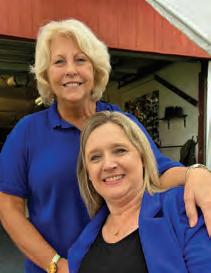


3 cups (about 1 medium-sized) butternut squash, cooked and mashed
⅓ cup butter, softened
3 eggs
2 teaspoons vanilla extract
½ cup heavy whipping cream
1 cup white sugar
½ cup sweetened condensed milk
Preheat oven to 350 degrees. Butter a 2-quart casserole dish. Mix together all of the ingredients until smooth. Pour into a buttered dish and bake for 40 minutes. Mix the following toppings while the casserole is baking.
Topping:
1 cup brown sugar
⅓ cup flour
½ cup butter, softened
½ cup nuts, chopped
Sprinkle on top of the casserole and bake for 5 minutes or until it begins to blend. Cook’s note: I like a lot of topping, so I sometimes double it.
Butternut Squash Casserole

































Inogen® Portable Oxygen Concentrators are used by over 1 million patients worldwide to get their oxygen therapy on-the-go. Their compact size and long battery life help you stay active and engaged in life.


CALL NOW for a FREE Doctor Discussion Guide and see if your insurance would cover our device.
USES: The Inogen Portable Oxygen Concentrator provides a high concentration of supplemental oxygen to patients requiring respiratory therapy on a prescriptive basis. It may be used in home, institution, vehicle, and various mobile environments. DO NOT USE IF: This device is not intended to be used in any way other than described in the indications for use. Do not use in parallel or series with other oxygen concentrators or oxygen therapy devices. This device is to be used as an oxygen supplement and is not intended to be life sustaining or life supporting. ONLY use this product if the patient is capable of spontaneous breath, able to inhale and exhale without the use of a machine. The conserving, or pulse dose, oxygen delivery technique used by this device is contraindicated in persons whose breathing during normal resting would be unable to trigger the device. Proper device triggering, setup and operation must be confirmed by an experienced clinician or other respiratory professional. Not for pediatric use. Not for use by tracheotomized patients. WARNINGS: The device produces enriched oxygen gas, which accelerates combustion. Do not allow smoking or open flames within 2m (6.56ft) of this device while in use. If you feel ill or uncomfortable, or if the concentrator does not signal an oxygen pulse and you are unable to hear and/or feel the oxygen pulse, consult your equipment provider and/or your physician immediately. If you are unable to communicate discomfort, you may require additional monitoring and or a distributed alarm system to convey the information about the discomfort and or the medical urgency to your responsible caregiver to avoid harm. Use only spare parts recommended by the manufacturer to ensure proper function and to avoid the risk of fire and burns. To avoid danger of choking or strangulation hazard, keep cords away from children and pets. TALK TO YOUR HEALTH CARE PROVIDER: The oxygen flow setting must be determined and recorded for each patient individually by the prescriber, including the configuration of the device, its parts, and the accessories. It is the responsibility of the patient to periodically reassess the setting(s) of the therapy for effectiveness. The proper placement and positioning of the prongs of the nasal cannula in the nose is critical for oxygen to be delivered.
You’ll be thankful you prepared in the fall for colder weather when you receive your first winter bill. Just as you pull out your winter gear before you need it, prepping your home for the coming season is a great idea.
The following steps can be taken now to use less energy at home before the winter chill sets in. They also help lower strain on the electric grid during extreme winter weather when energy use is at its peak in your community.
First, let’s consider your home’s layers. Just like layering up those winter flannels, fleeces and down jackets with waterproof, wind-stopping shells, gloves and hats, your home needs layers, too. Air sealing and insulation protect your home from the elements while locking in the warm air to keep you cozy. The same applies to hot weather, making air sealing and insulation a year-round efficiency upgrade.
To offset the costs, federal tax credits for energy efficiency upgrades are available through Dec. 31, 2025. Homeowners can claim a total of 30% of the cost of installation, up to $3,200. Tax credits are available for insulation, heat pumps, air conditioning systems and more. There’s even a tax credit for electrical panel upgrades, which might be needed to accommodate new energy efficient equipment.
There’s also a $150 tax credit for an energy audit, which allows a pro to help determine what your home needs and how to prioritize potential projects. Visit energystar.gov for more information.
When it comes to do-it-yourself projects, there are a few upgrades you can take care of yourself. Lock in savings with window cleaning and maintenance.

Filters should be checked every three months and replaced if needed.

Make sure sash locks and window cranks are in good working order and cleaned of any dirt and leaves. Debris can keep them from closing snugly. I find the crevice tool attachment on my vacuum cleaner, combined with a small, dry scrub brush or an old toothbrush, works great. The locks should pull the top and bottom window sashes together tightly. For casement windows, the locks should pull the window tightly to the frame.
Although it might not seem like a significant difference, reducing airflow through and around windows can make your home more comfortable in the winter. Replacing broken or nonfunctional sash locks can be a reasonable DIY project, but it’s best to avoid doing it when the winter winds are blowing. Also, use caulk to seal all gaps around the window trim. If you have operable storm windows, make sure they close.
If you have a forced-air heating or air conditioning system, replace the filter. First, turn the system off to check it. If your filter is dirty, leave it in place until you have a replacement. Running your system without a filter can send any dust or dirt in the ductwork directly into the components and damage your equipment. Make a note of the filter’s size on your shopping list or take a picture of the filter with your phone so you can reference it when running errands.
Also, stocking up on filters can save you money. I bought a 12-pack of filters for $72—$6 each. A similar filter sold separately was $10. Don’t see a bulk pack at your local hardware store? Ask at the customer service desk. They may be able to order them for you.
This fall, look for opportunities to protect your home from the elements and maintain your equipment before the cold of winter.
With Fields & Forests, you can have a successful farm and get paid to grow healthy forests. By enrolling, you can diversify your land by planting pine on your unused or marginal land, while still growing crops or raising livestock on adjacent acres.
No upfront costs, no change in ownership, no impact on your land rights, no sharing your timber revenue, just expert support and guaranteed payments for 30 years.
Now enrolling landowners with 30+ acres of open fields in Alabama, as well as Florida, Georgia, and South Carolina.


Learn more at fieldsandforests.org
Collectors love “lasts” as no collection is complete without the last coin struck. Last year coins are often hard to find and always in demand. Little did master engraver George T. Morgan know the legacy he was creating when he designed what has become known as “The King of Silver Dollars” but it came to an end 104 years ago with the last-year 1921 Morgan Silver Dollar, the most beloved coin in American history.
Rarcoa®, America’s Oldest Coin Company, is announcing the public release of 832 of the very last year 1921 Morgan Silver Dollars, struck at the iconic Philadelphia Mint. Each coin today comes in Brilliant Uncirculated condition, pristine as the day they were struck!
Struck in 1921, each coin is one hundred and four years old. Could Charles Lindbergh have carried your coin in his pocket during his flight across the Atlantic? Or maybe your great-grandfather carried it while storming the beaches of Normandy during World War II before ending up in a small coin shop in Tuscaloosa, Oklahoma. Each coin has its own unique history and you can hold 104 years of American history when you buy yours today!
This same 1921 Morgan Silver Dollar sells elsewhere for as much as $141. But thanks to Rarcoa’s buying power and numismatic expertise, you can own one for as little as $59, in quantity while supplies last.
That’s a difference of up to $82!


Last Year











BUY MORE AND SAVE!
Act now and you can SAVE BIG when you buy more! But don’t wait, our inventory won’t last long.
1921 Morgan Silver Dollar Brilliant Uncirculated 1-4 coins - $69 each 5-9 coins - $64 each, Save

In recent decades, populations of federally protected cormorants exploded across North America. Because these big black fowl eat so many fish, and smell like it, many anglers detest these birds. However, some catfish anglers have learned to love the foul fowl.
Double-crested cormorants can measure 29 to 36 inches long with wings spanning up to 52 inches. Each winter, flocks of cormorants head south, just like waterfowl and other bird species. Many remain in Alabama all year long, but others head back north in the spring.
In the fall and winter, anglers commonly see huge flocks of cormorants floating on the surface of many lakes. Cormorant concentrations could indicate good numbers of fish in an area. The big black birds primarily eat fish, but they also eat amphibians, crustaceans and other things. They can dive down 25 feet and remain underwater for more than a minute.
Cormorants love shad most of all, as do many other fish, like bass, crappie and catfish. After filling their bellies with fish, cormorants perch on tree branches. They must stretch out their wings to dry their feathers in the sun before diving for fish again. While sitting in the trees resting and digesting, the shad-stuffed birds inevitably relieve themselves. Waste deposits can stain tree trunks, branches and foliage white, but some of it drops into the water.
What sounds gross to humans rings the dinner bell for catfish. With sensors covering its entire body, a catfish swims through the water like a giant tongue tasting everything. With thousands of taste buds per square centimeter in its skin and even more densely packed sensors in its whiskers, catfish can detect minute food particles or scents over long distances. When the malodorous “deposits” hit the water, catfish smell it from a long way off and come looking for an easy fishy meal.

Cypress trees line the shorelines of many Alabama lakes and rivers. In reservoirs, many cypress trees grow well away from
the shorelines. A cypress tree can grow in water up to about seven feet deep. As long as the birds stay in the trees, catfish will hover under them waiting for their next meal.
First look for resting cormorants. Whenever possible, find birds that have been sitting in trees for a while. Failing that, look for trees freshly stained white with waste in or near water about three to seven feet deep. Also look for any activity around the tree trunks that could indicate feeding fish.
Normally, birds fly off as boats approach. After chasing away the birds, attach a live or whole fresh shad to a hook with no weight. If necessary for fishing current or in windy conditions, use a small jighead or split-shot to get the bait down to the bottom. Use as little weight as necessary.
Flip the shad close to the tree trunks. Let the baitfish flutter down naturally into the water. Usually, a catfish slurps the bait instantly, or not at all. With hungry catfish around, the bait will never hit bottom before a catfish grabs it. If a bait does hit bottom, let it rest a few seconds. Then, pop it up to the surface. Move it a foot or two and let it flutter down again.
Whenever possible, fish completely around trees growing in deeper water. Catfish might prefer one side or the other. Some trees could produce several good catfish in minutes, so keep fishing a spot as long as fish keep biting. After a few minutes with no action, move to another tree. Don’t waste time fishing unproductive trees.
For this kind of fishing, anglers don’t need to head out before dawn. Let the birds enjoy their breakfast. In mid-morning, birds stuffed with fish get sleepy and look for a place to take a nap in the sun. Sunshine helps the fishing because catfish can see the bait better when sunlight filters through the water. In addition, on a frosty day, sunshine hitting the water surface warms it a few degrees. Just one or two degrees warmer could make cold-blooded catfish more active.
Any reservoirs with abundant dead trees still standing in deep water could make great places to catch catfish. Cypress trees growing out from shorelines also attract birds. Also look for fallen trees with branches sticking out over the water.
Anyone could try flipping the trees for catfish. This fishing method makes a great way to teach children how to fish.




7:51 Sa 22 NA 12:42 - 2:42 6:45 - 8:15 7:09 - 8:39 Su 23 1:06 - 3:06 1:30 - 3:30 7:33 - 9:03 7:57 - 9:27 Mo 24 1:54 - 3:54 2:18 - 4:18 8:21 - 9:51 8:45 - 10:15
Tu 25 2:42 - 4:42 3:06 - 5:06 9:09 - 10:39 9:33 - 11:03
We 26 3:30 - 5:30 3:54 - 5:54 9:57 - 11:27 10:21 - 11:51
Th 2 7 4:18 - 6:18 4:42 - 6:42 10:45 - 12:15 11:09 - 12:39
Fr 28 5:06 - 7:06 5:30 - 7:30 11:33 - 1:03 11:57 - 1:27
Sa 29 5:54 - 7:54 6:18 - 8:18 NA 12:45 - 2:15
Su 30 6:42 - 8:42 7:06 - 9:06 1:09 - 2:39 1:33 - 3:03
DECEMBER A.M. PM AM PM
Mo 1 7:30 - 9:30 7:54 - 9:54 1:57 - 3:27 2:21 - 3:51
Tu 2 8:18 - 10:18 8:42 - 10:42 2:45 - 4:15 3:09 - 4:39
We 3 9:06 - 11:06 9:30 - 11:30 3:33 - 5:03 3:57 - 5:27
Th 4 10:42 - 12:42 11:06 - 1:06 FULL MOON 5:09 - 6:39 5:33 - 7:03
Fr 5 11:30 - 1:30 11:54 - 1:54 5:57 - 7:27 6:21 - 7:51
Sa 6 NA 12:42 - 2:42 6:45 - 8:15 7:09 - 8:39
Su 7 1:06 - 3:06 1:30 - 3:30 7:33 - 9:03 7:57 - 9:27
Mo 8 1:54 - 3:54 2:18 - 4:18 8:21 - 9:51 8:45 - 10:15
Tu 9 2:42 - 4:42 3:06 - 5:06 9:09 - 10:39 9:33 - 11:03
We 10 3:30 - 5:30 3:54 - 5:54 9:57 - 11:27 10:21 - 11:51
Th 11 4:18 - 6:18 4:42 - 6:42 10:45 - 12:15 11:09 - 12:39
Fr 12 5:06 - 7:06 5:30 - 7:30 11:33 - 1:03 11:57 - 1:27
Sa 13 5:54 - 7:54 6:18 - 8:18 NA 12:45 - 2:15
Su 14 6:42 - 8:42 7:06 - 9:06 1:09 - 2:39 1:33 - 3:03
Mo 15 7:30 - 9:30 7:54 - 9:54 1:57 - 3:27 2:21 - 3:51
Tu 16 8:18 - 10:18 8:42 - 10:42 2:45 - 4:15 3:09 - 4:39
We 1 7 9:06 - 11:06 9:30 - 11:30 3:33 - 5:03 3:57 - 5:27
Th 18 9:54 - 11:54 10:18 - 12:18 4:21 - 5:51 4:45 - 6 ;15
Fr 19 10:18 - 12:18 10:42 - 12:42 4:48 - 6:28 5:11 - 6:41
Sa 20 10:42 - 12:42 11:06 - 1:06 NEW MOON 5:09 - 6:39 5:33 - 7:03
Su 21 11:30 - 1:30 11:54 - 1:54 5:57 - 7:27 6:21 - 7:51
Mo 22 NA 12:42 - 2:42 6:45 - 8:15 7:09 - 8:39
Tu 23 1:06 - 3:06 1:30 - 3:30 7:33 - 9:03 7:57 - 9:27
We 24 1:54 - 3:54 2:18 - 4:18 8:21 - 9:51 8:45 - 10:15
Th 25 2:42 - 4:42 3:06 - 5:06 9:09 - 10:39 9:33 - 11:03
Fr 26 3:30 - 5:30 3:54 - 5:54 9:57 - 11:27 10:21 - 11:51
Sa 2 7 4:18 - 6:18 4:42 - 6:42 10:45 - 12:15 11:09 - 12:39
Su 28 5:06 - 7:06 5:30 - 7:30 11:33 - 1:03 11:57 - 1:27
Mo 29 5:54 - 7:54 6:18 - 8:18 NA 12:45 - 2:15
Tu 30 6:42 - 8:42 7:06 - 9:06 1:09 - 2:39 1:33 - 3:03
We 31 7:30 - 9:30 7:54 - 9:54 1:57 - 3:27 2:21 - 3:51
The Moon Clock and resulting Moon Times were developed 44 years ago by Doug Hannon, one of America’s most trusted wildlife experts and a tireless inventor. The Moon Clock is produced by DataSport, Inc. of Atlanta, GA, a company specializing in wildlife activity time prediction. To order the 2025 Moon Clock, go to www.moontimes.com.







Outside factors, such as fuel and equipment costs and extreme weather, can impact electricity prices. But you have the power to control home energy consumption by taking proactive steps to reduce energy use.
The thermostat is one of the best places to lower your energy use because heating and cooling account for a significant portion of home energy consumption. During winter months, adjust your thermostat to the lowest comfortable setting to reduce energy use. The Dept. of Energy recommends 68 degrees or lower.
Plan energy-intensive chores and tasks, such as running the dishwasher or washing clothing, during o -peak energy hours, when the demand for electricity is lower. O -peak times are early in the morning or late evenings. By scheduling these activities during o -peak periods, you can help keep rates lower, reduce demand and relieve pressure on the grid.





According to ENERGY STAR®, about 20% of heated or cooled air that moves through a home is lost due to lack of proper insulation and air leaks. Ensure your home has su cient insulation levels and seal air leaks around windows and doors with caulk and weatherstripping. This is a simple, e ective way to lower energy use and improve indoor comfort.




The health of your heating and cooling system is essential for comfort and can greatly impact energy bills. Maintain your system by regularly replacing dirty filters and scheduling annual inspections for maintenance and necessary repairs.

Fewof us spend time thinking about where our electricity comes from – it’s just there when we flip on the switch.
But behind the scenes, people are working around the clock to keep energy flowing safely and reliably. One of those is Matt Rasmussen, an Alabamian who has spent his entire career in the utility industry. Now, he’s been named the Chief Nuclear Officer at the Tennessee Valley Authority (TVA).
Many in our communities will find Matt’s story a relatable one. He’s a Birmingham native who started his career at TVA’s Browns Ferry Nuclear Plant in Athens, Alabama, where TVA energy powers rural homes and farms. Over the past 20 years, Rasmussen worked his way up through the ranks, from engineering and maintenance positions to plant manager. And as of Oct. 1, he holds the top nuclear job at TVA.
“Matt brings not only a wealth of nuclear expertise, but also the kind of determination and leadership that is critical to leading one of the nation’s largest nuclear fleets,” said TVA President and CEO Don Moul.
Rasmussen’s leadership will be a catalyst for growth as TVA continues to invest in the future of nuclear energy. Rasmussen is ready for the challenge.
“Nuclear leadership means more than maintaining excellence, it means strengthening performance today while building the foundation for tomorrow’s energy solutions,” Rasmussen said.
“At TVA, we’re not just operating one of the nation’s safest and most reliable nuclear fleets; we’re advancing the next generation of nuclear energy technologies. I’m committed to fostering a culture of innovation and continuous improvement as we lead America’s energy independence.”


T VA’s nuclear plants generate over 40% of the electricity used by people in the Valley, power that is affordable, dependable and clean.
As TVA and local power providers work to build America’s energy future, Rasmussen brings a clear vision: keep improving, keep innovating, and keep serving the people of the Tennessee Valley. With deep roots in Alabama and a passion for progress, he’s ready to lead TVA’s nuclear program — and that’s good news for all of us who depend on it.
Closing Deadlines (in our office):
January 2026 Issue by November 25
February 2026 Issue by December 25
March 2026 Issue by January 25
Ads are $1.75 per word with a 10 word minimum and are on a prepaid basis; Telephone numbers, email addresses and websites are considered 1 word each. Ads will not be taken over the phone. You may email your ad to hdutton@areapower.com; or call (800) 4102737 ask for Heather for pricing.; We accept checks, money orders and all major credit cards. Mail ad submission along with a check or money order made payable to ALABAMA LIVING, 340 TechnaCenter Dr., Montgomery, AL 36117 Attn: Classifieds.
FUNERAL INSURANCE PLANS FOR ANY BUDGET. No Exam, Easy Qualification. Visit finalexpenseassured.com or call (813)352-2587
OWNERS – Join the fastest growing regional site in Alabama. Low annual fee. Verified Owners, no booking fees or commissions. Alabama Vacation Home Rentals. Locally Owned and Operated. (251)333-6500, ALAVHR.com
GULF SHORES / ORANGE BEACH / FORT MORGAN – Choose from hundreds of beach houses and condos! Verified Owners. No Booking Fees. ALAVHR.com
GATLINBURG – DOWNTOWN LUXURY CREEKSIDE CONDO – 2BR / 2BA, sleeps 6 –carsellinggirl@gmail.com (256)393-4526


MENTONE, AL LOOKOUT MOUNTAIN COTTAGE RENTALS – Best brow views, River Front –cottagesofmentone.com, Call or text (504) 481-8666
PANAMA CITY BEACH CONDO – Owner rental – 2BR / 2BA, wireless internet, just remodeled inside and outside – (502)7777819, larrysusemichel@reagan.com, www. theroneycondo.com
Pet Friendly – Save $$$ by booking directly from Verified Owners. ALAVHR.com
SONGBIRD STORY FARMHOUSE – Authentic 1940’s, vintage furniture/decor, fireplace, gazebo, Yellowhammer Tower, fishing, firepit. Old-fashioned Christmas. Jackson County (Pisgah), AL. Airbnb, Vrbo. Call/text (256) 605-1470, oldcottonwoodfarm@gmail.com
MILITARY / SERVICE DISCOUNTS on dozens of rentals. No Booking Fees. (251)333-6500, ALAVHR.com
FREE BIBLE CORRESPONDENCE COURSE – write to P.O. Box 52, Trinity, AL, 35673
FREE MATERIALS: When Church / Government Unite, Enforcing Sunday Law, The MARK OF THE BEAST is HERE! Don’t be deceived, be informed! Leave mailing address only – TBSM, POB 374, Ellijay, GA 30540 – TBSMADS@yahoo. com – (888)211-1715
GROW MUSCADINES AND BLACKBERRIES , half dollar size – We offer over 200 varieties of Fruit

and Nut Trees plus Vines and Berry Plants . Free color catalog. 1-800-733-0324. Ison’s Nursery, P.O. Box 190, Brooks, GA 30205 Since 1934 www.isons.com
ARE YOU CHANGING YOUR ADDRESS? If you’re a member of an electric cooperative, please contact your local co-op office with your new address so you can keep receiving Alabama Living. If you’re not a member of an electric co-op, send your new address to contact@ alabamaliving.coop.


Sometimes in your life, you do something so stupid that even though you’re humiliated, you know it should be written down. This is one of those stories.
Well, in truth, my wife Carol threatened to write it if I didn’t. So here goes.
It was December 1972 and I had been dating Carol for six months. It was the end of the first semester and we were on holiday break. So, what should a couple of broke college kids do? Maybe I could scrape up enough change for a trip to McDonald’s.
Predictably, when I showed up at Carol’s house, she wasn’t ready. So while she finished primping, I thought it would be a good idea to wash my car, a plain, green, ‘69 Camaro.
I opened the double gate of the chain link fence and drove into the backyard. “This won’t take long,” I thought to myself, as I filled a bucket with water and soap.
Within a few minutes, my Camaro was a clean, twinkling emerald. Carol appeared on the back porch ready to go. This was going to be a good day.
Wrong. Once I cranked the Camaro and made a tight turn to head out front, I heard a thud. Suddenly, it stopped. I stepped on the gas and the engine raced, but the car didn’t move. It felt like something was holding it back.
Something was. When I looked underneath my Camaro, I discovered that I had run over a mimosa tree stump. And it was wedged against my rear axle.

“How can you a miss a tree stump?” you ask. I still don’t know. Even though a Camaro is low-slung and close to the ground, that’s no excuse. This was a special kind of stupidity. If there was an Olympic event for idiots that year, I would have won a gold medal.
I was screaming at the car, and kicking the tires when Carol re-emerged on the back porch.
“What have you done?” she asked with genuine concern.
“I’ve got my blankety-blank car stuck on a stump! Why do you have a tree stump in your back yard?”
She replied calmly, “The real question is, why is your car stuck on a tree stump in my back yard?”
How dare she use common sense against my anger and sarcasm.
I yelled, “Come over here and help.”
“What do you want me to do?”
“Get in the car. When I give you the word, step on the gas and I’ll push.”
She nodded, and slid in the front seat. Then I put my hands on the trunk, and shouted, “Gun it!”
She stepped on the gas pedal, and the engine roared. However, the tires just spun, sinking the rear end of the car even lower, and showering me with mud. In an instant, I looked like a Navy Seal trying to camouflage himself.
I yelled, “No, No!” But she thought I said, “Go, go!” and gunned the motor, spewing more crud all over me.
Quickly I stopped pushing and began yelling words that a Methodist would never say. Come to think of it, I don’t even think a rapper would have said them.
Carol came out of the car, looked at me, and said, “What now?”
I answered weakly, “I don’t know,” and sat on the porch, shaking my muddy head. I was defeated.
Stump 1, Joe 0.
Fortunately, Carol’s mother had already called a towing service, and within an hour they arrived. In the meantime, she washed my clothes while I sat on the couch, wearing her bathrobe.
It took them about 30 seconds to hook my car up, remove it from the stump, and pull it into the front yard. And there it sat, a muddy mess.
We got in the car and headed directly to a drive-through car wash. We didn’t need to go to McDonald’s anyway.








































See Page 33
Send us your “Alabama Wildlife” snapshots! See page 9
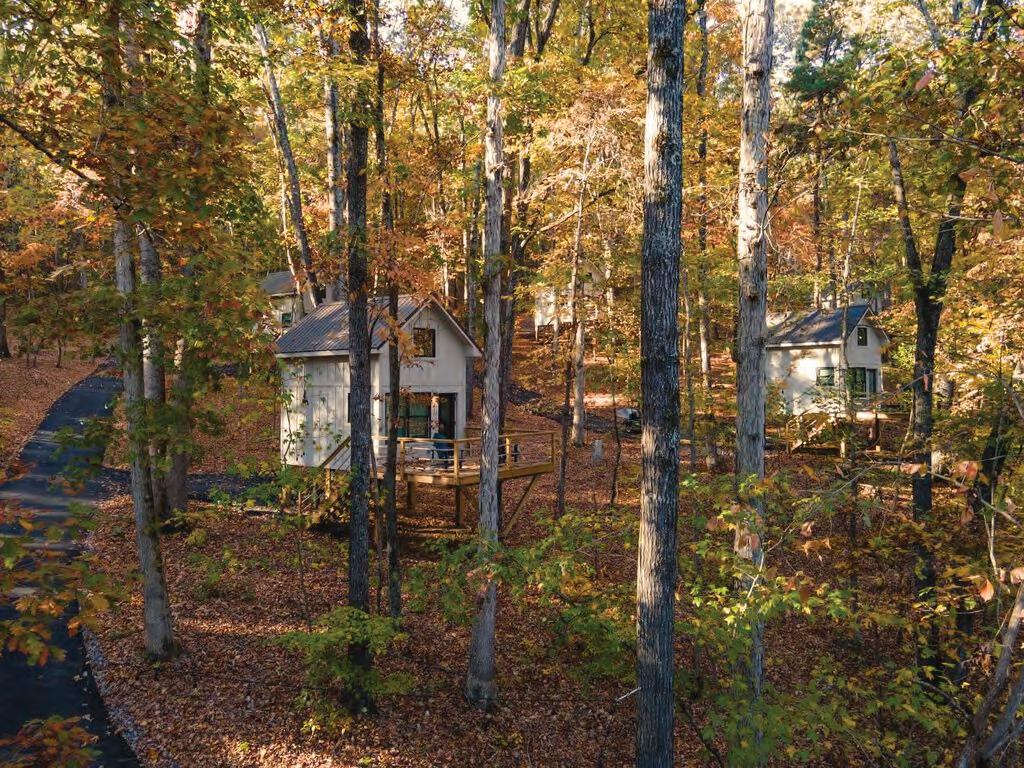


Give the gift of nature, gift cards available!
At ReTreet Resort & Spa, comfort and n ature come together in perfect harmony. C hoose from luxury treehouses, glamping tents, tiny cottages, and mountain-view c abins—many featuring private hot tubs, c ozy fire pits, and views of the Guntersville L ake or surrounding hills.
Experience the Nordic Cycle, where hot and c old blend together through the sauna, cold plunge, and cedar soaking tub. Take your relaxation further with a massage or facial a t Leaf and Stone Spa, just a short golf cart r ide away. An ideal winter retreat and the p erfect place to host extra holiday guests.
